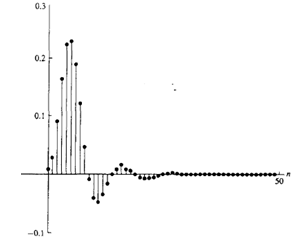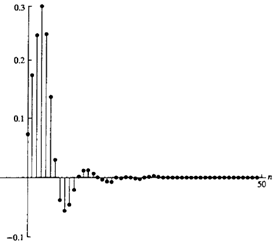This set of Digital Signal Processing Multiple Choice Questions & Answers (MCQs) focuses on “Pade Approximation Method”.
1. Which of the following techniques of designing IIR filters do not involve the conversion of an analog filter into digital filter?
a) Bilinear transformation
b) Impulse invariance
c) Approximation of derivatives
d) None of the mentioned
View Answer
Explanation: Except for the impulse invariance method, the design techniques for IIR filters involve the conversion of an analog filter into a digital filter by some mapping from the s-plane to the z-plane.
2. Using which of the following methods, a digital IIR filter can be directly designed?
a) Pade approximation
b) Least square design in time domain
c) Least square design in frequency domain
d) All of the mentioned
View Answer
Explanation: There are several methods for designing digital filters directly. The three techniques are Pade approximation and least square method, the specifications are given in the time domain and the design is carried in time domain. The other one is least squares technique in which the design is carried out in frequency domain.
3. What is the number of parameters that a filter consists of?
a) M+N+1
b) M+N
c) M+N-1
d) M+N-2
View Answer
Explanation: The filter has L=M+N+1 parameters, namely, the coefficients {ak} and {bk}, which can be selected to minimize some error criterion.
4. The minimization of ε involves the solution of a set of non-linear equations.
a) True
b) False
View Answer
Explanation: In general, h(n) is a non-linear function of the filter parameters and hence the minimization of ε involves the solution of a set of non-linear equations.
5. What should be the upper limit of the solution to match h(n) perfectly to the desired response hd(n)?
a) L
b) L+1
c) L-1
d) L+2
View Answer
Explanation: If we select the upper limit as U=L-1, it is possible to match h(n) perfectly to the desired response hd(n) for 0 < n < M+N.
6. For how many values of the impulse response, a perfect match is present between h(n) and hd(n)?
a) L
b) M+N+1
c) 2L-M-N-1
d) All of the mentioned
View Answer
Explanation: We obtain a perfect match between h(n) and the desired response hd(n) for the first L values of the impulse response and we also know that L=M+N+1.
7. The degree to which the design technique produces acceptable filter designs depends in part on the number of filter coefficients selected.
a) True
b) False
View Answer
Explanation: The degree to which the design technique produces acceptable filter designs depends in part on the number of filter coefficients selected. Since the design method matches hd(n) only up to the number of filter parameters, the more complex the filter, the better the approximation to hd(n).
8. According to this method of designing, the filter should have which of the following in large number?
a) Only poles
b) Both poles and zeros
c) Only zeros
d) None of the mentioned
View Answer
Explanation: The major limitation of Pade approximation method, namely, the resulting filter must contain a large number of poles and zeros.
9. Which of the following conditions are in the favor of Pade approximation method?
a) Desired system function is rational
b) Prior knowledge of the number of poles and zeros
c) Desired system function is rational & Prior knowledge of the number of poles and zeros
d) None of the mentioned
View Answer
Explanation: The Pade approximation method results in a perfect match to Hd(z) when the desired system function is rational and we have prior knowledge of the number of poles and zeros in the system.
10. Which of the following filters will have an impulse response as shown in the below figure?

a) Butterworth filters
b) Type-I chebyshev filter
c) Type-II chebyshev filter
d) None of the mentioned
View Answer
Explanation: The diagram that is given in the question is the impulse response of Butterworth filter.
11. For what number of zeros, the approximation is poor?
a) 3
b) 4
c) 5
d) 6
View Answer
Explanation: We observe that when the number of zeros in minimum, that is when M=3, the resulting frequency response is a relatively poor approximation to the desired response.
12. Which of the following pairs of M and N will give a perfect match?
a) 3,6
b) 3,4
c) 3,5
d) 4,5
View Answer
Explanation: When M is increased from three to four, we obtain a perfect match with the desired Butterworth filter not only for N=4 but for N=5, and in fact, for larger values of N.
13. Which of the following filters will have an impulse response as shown in the below figure?

a) Butterworth filters
b) Type-I chebyshev filter
c) Type-II chebyshev filter
d) None of the mentioned
View Answer
Explanation: The diagram that is given in the question is the impulse response of type-II chebyshev filter.
Sanfoundry Global Education & Learning Series – Digital Signal Processing.
To practice all areas of Digital Signal Processing, here is complete set of 1000+ Multiple Choice Questions and Answers.
If you find a mistake in question / option / answer, kindly take a screenshot and email to [email protected]
